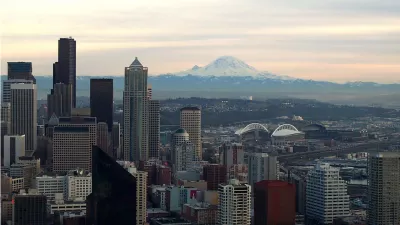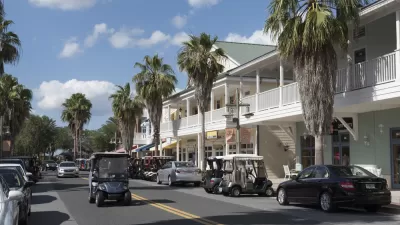In this opinion piece, Brookings demographer William H. Frey looks at three years of census data and discusses whether urban growth will stay through the decade or whether the U.S. will return to its traditional, post-War suburban growth patterns.

We take a third look at the May 22 release of data from the U.S. Census Bureau as to what it may say about whether previously posted urban or suburban/exurban theories of population growth will prevail for this decade.
William H. Frey asks, "Is this city growth revival here to stay? Or, is it a lingering symptom of the recession, mortgage meltdown and the plight of still stuck-in-place young adults?"
The question is an important one for urbanists. "From 2000 to 2010 as with many prior years, suburban growth substantially exceeded that of primary cities," he writes. This could be the decade where growth patterns reverse. So far, it has, but it may be slipping.
While he answers the question by writing, "The new statistics, which update city populations through July 2013, give some credence to both theories," he appears to favor the urban theory.
In the city versus suburb realm, the new numbers once again affirm a reversal that counters decades of suburban-dominated regional growth among metro areas with more than 1 million people. Now, for three years running, primary cities are growing faster than their suburbs (See Figure 2).
He begins with much data that would lead one to believe that it will be the decade of urban growth.
For each of the last three years, cities with populations exceeding 250,000 grew at rates exceeding 1 percent—far higher than their average annual rate of 0.49 percent over the 2000-2010 decade (Figure 1.)
Then he adds that "despite the overall gains, growth rates slowed in the most recent year for 45 of the 77 cities over 250,000 in population, but for the most part, the growth rate declines were less than 0.5 percent."
"(T)he new numbers for 2012-13, suggest a closing of the city-suburb growth gap with the small downtick in city growth and an even tinier suburban growth uptick" [which was the basis of the piece by The Wall Street Journal's Neil Shah.]
And it wasn't just the suburbs that grew.
This modest suburban growth rise is reinforced by a separate updated analysis of exurban counties that showed their population growth rise from a low 0.4 percent in 2011-2012 to 0.6 percent in 2012-2013. This is still well below the exurban growth rates of around 2 percent during the high suburbanization years in the middle of last decade.
The exurban growth is a marked turnaround from what Frey writes in his April 6, 2012 opinion, "The Demographic Lull Continues, Especially in Exurbia," defined as "destinations for new homebuyers at the outer edge of the metropolitan frontier."
One region that hasn't turned around is "small town America." In his March 31, 2014 opinion, Frey writes that "the population living entirely outside metropolitan areas—nearly two-thirds of the nation’s 3100 counties—shows an actual population loss for the third year in a row."
FULL STORY: Will this be the Decade of Big City Growth?

Alabama: Trump Terminates Settlements for Black Communities Harmed By Raw Sewage
Trump deemed the landmark civil rights agreement “illegal DEI and environmental justice policy.”

Planetizen Federal Action Tracker
A weekly monitor of how Trump’s orders and actions are impacting planners and planning in America.

Why Should We Subsidize Public Transportation?
Many public transit agencies face financial stress due to rising costs, declining fare revenue, and declining subsidies. Transit advocates must provide a strong business case for increasing public transit funding.

Understanding Road Diets
An explainer from Momentum highlights the advantages of reducing vehicle lanes in favor of more bike, transit, and pedestrian infrastructure.

New California Law Regulates Warehouse Pollution
A new law tightens building and emissions regulations for large distribution warehouses to mitigate air pollution and traffic in surrounding communities.

Phoenix Announces Opening Date for Light Rail Extension
The South Central extension will connect South Phoenix to downtown and other major hubs starting on June 7.
Urban Design for Planners 1: Software Tools
This six-course series explores essential urban design concepts using open source software and equips planners with the tools they need to participate fully in the urban design process.
Planning for Universal Design
Learn the tools for implementing Universal Design in planning regulations.
Caltrans
Smith Gee Studio
Institute for Housing and Urban Development Studies (IHS)
City of Grandview
Harvard GSD Executive Education
Toledo-Lucas County Plan Commissions
Salt Lake City
NYU Wagner Graduate School of Public Service





























